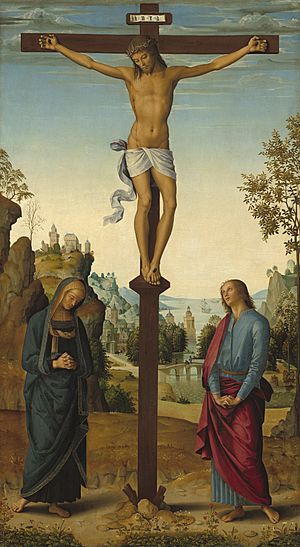Stabat Mater facts for kids

The Stabat Mater is a very old Christian song, or hymn, from the 1200s. It describes the deep sadness of Mary, Jesus Christ's mother, as she watched him being crucified. The name "Stabat Mater" comes from its first line, "Stabat Mater dolorosa". This Latin phrase means "the sorrowful mother was standing".
People believe that either a Franciscan friar named Jacopone da Todi or Pope Innocent III wrote this hymn. Today, the Stabat Mater is sung during church services on the day we remember Our Lady of Sorrows. Many famous composers from Western countries have also created music for this special hymn.
Contents
When Was the Stabat Mater Written?
The Stabat Mater was often thought to be written by Jacopone da Todi. He lived from about 1230 to 1306. However, this idea has been questioned.
The oldest known copy of the Stabat Mater with music was found in a book from the 1200s. This book belonged to a group of Dominican nuns in Bologna, Italy.
By the end of the 1300s, the Stabat Mater was very well known. Georgius Stella wrote about it being used in 1388. Other historians also noted its use later in that century. Around 1399, in a place called Provence, people used it during special nine-day processions.
The Council of Trent later stopped the use of many hymns like the Stabat Mater. But in 1727, Pope Benedict XIII brought it back. He added it to the prayer book for the Feast of the Seven Dolours of the Blessed Virgin Mary.
What Does the Stabat Mater Say?
The Stabat Mater is a poem that describes Mary's pain as she stands by the cross. It helps people understand her sorrow. The poem asks to share in her suffering and in Jesus's pain.
Here are a few lines from the poem in Latin and English:
|
1. Stabat mater dolorósa |
At the Cross her station keeping, |
The poem also asks for strength and protection. It hopes that by sharing in Mary's grief, people can become closer to God.
Music for the Stabat Mater
Many composers have written beautiful music for the Stabat Mater poem. Here are some of them:
- Josquin des Prez
- Orlande de Lassus (1585)
- Palestrina: Stabat Mater (c.1590)
- Giovanni Felice Sances (1643)
- Marc-Antoine Charpentier H.15 & H.387 (1685–90)
- Louis-Nicolas Clérambault C. 70 (17..)
- Sébastien de Brossard SdB.8 (1702)
- Emanuele d'Astorga (1707)
- Vivaldi: Stabat Mater (1712)
- Domenico Scarlatti (1715)
- Nicola Fago (1719)
- Scarlatti: Stabat Mater (1723)
- Antonio Caldara (~1725)
- Agostino Steffani (1727)
- Pergolesi: Stabat Mater (1736)
- Nicola Logroscino (1760)
- Florian Leopold Gassmann (~1765)
- Haydn: Stabat Mater (1767)
- Giuseppe Tartini (1769)
- Tommaso Traetta (1770)
- Antonio Soler (1775)
- Boccherini: Stabat Mater (1781, 1801)
- Franz Ignaz Beck (1782)
- Pasquale Cafaro (1784)
- Schubert: Stabat Mater in G minor (1815) and Stabat Mater in F minor (1816)
- Rossini: Stabat Mater (1831–1841)
- Peter Cornelius (1849)
- Liszt: part of the oratorio Christus (1862–1866)
- Dvořák: Stabat Mater (1876–1877)
- Laura Netzel (1890)
- Josef Bohuslav Foerster: Op. 56 (1891–1892)
- František Musil: Op. 50 (1893)
- Giuseppe Verdi (1897)
- Charles Villiers Stanford (1906)
- Toivo Kuula (1919)
- George Oldroyd (1922)
- Szymanowski: Stabat Mater (1925–1926)
- Johann Nepomuk David (1927)
- Lennox Berkeley (1947)
- Julia Perry (1947)
- Poulenc: Stabat Mater (1950)
- Penderecki: in St Luke Passion (1963–1966)
- Pärt: Stabat Mater (1985)
- Knut Nystedt (1986)
- Amaral Vieira (1988)
- Trond Kverno (1991)
- Pawel Lukaszewski (1994)
- Vladimir Martynov (1994)
- Salvador Brotons (1997)
- Frank Ferko (1999)
- Vladimír Godár (2001)
- Bruno Coulais (2005)
- Karl Jenkins: Stabat Mater (2008)
- Paul Mealor (2009, revised 2010)
- Metropolitan Hilarion (2011)
- Franco Simone (2014)
- James MacMillan (2015)
- Vache Sharafyan
Most of these musical pieces use the original Latin words. However, Karol Szymanowski's version is in Polish, but it can also be sung in Latin. George Oldroyd's music uses the Latin words with an English translation for churches like the Anglican and Episcopalian ones.
See also
 In Spanish: Stabat Mater para niños
In Spanish: Stabat Mater para niños
- Catholic Mariology

